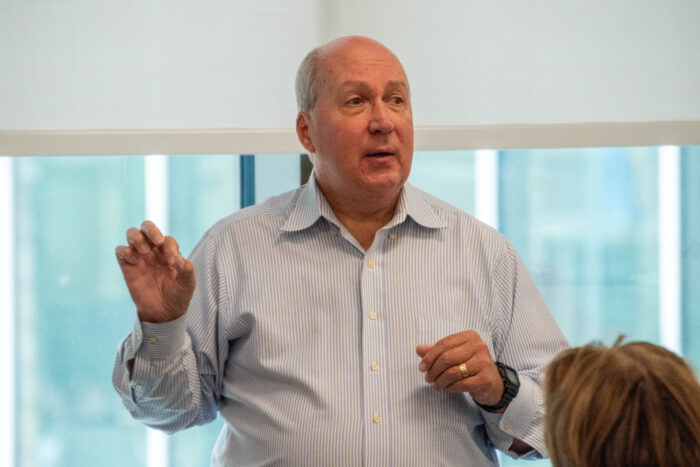
Many of the students who come to Michael Browne, instructor of practice in accounting in the Graduate School of Management, to learn how to read balance sheets will not be using that knowledge on the CPA exam. They’ll likely never even step foot in an accounting firm, unless they’re a customer.
Those learning from Browne these days include physicians and chemists, state government workers and liberal arts majors; all of them going for advanced business degrees.
“The way we approach it is that we’re not trying to prepare these students to be CPAs,” Browne says. “We’re trying to teach them how to understand what the numbers are and analyze them to make good business decisions.”
Students in Browne’s classes are often enrolled in the Executive MBA, MBA and MS in Finance programs. These students are often leaders in their organizations, which entails managing budgets, headcounts and strategic investments. Browne hopes that students emerge from his class more prepared for that reality.
“The higher up you go in leadership, the more numbers you’re going to deal with in your job,” Browne says.
You have a lot of students with non-business backgrounds in your classes; how does that influence the way you teach?
There are a lot of talented people with technical or arts backgrounds who find accounting incredibly daunting, if not downright intimidating. Even the business students who were marketing or human resources majors in their time as an undergraduate had a less than pleasant experience in accounting and come in concerned.
We’ve developed a system for success in accounting. It works so well that we can take an English major with no math background, teach them accounting concepts, and they’ll end up feeling comfortable with it by the end of the semester.
At the core of this model is a concept called “New, Do, Review.” Can you explain what that is?
We start with new material. Then, we move to hands-on activities to emphasize the learning so students can see the application. Finally, we review and repeat the process again in the next unit. The technology we’re able to use really helps. Instead of the old way, where we would assign a problem and students would have to write it out longhand, we use a software platform that has a lot of tools to format a problem and help you solve it. That greatly accelerates the speed at which we’re able to do this.
There are business simulations in your classes designed to help students apply this knowledge to real-world situations. Could you walk me through one of them?
In one of my classes, we use the simulation of a 3D-carbon bike manufacturing business. The student teams have to assume the roles of founders of a 3D-carbon bike company that sells all over the world. They then must decide what market they want to enter; they can enter markets in Bangalore, Rio de Janeiro, Brazil, Europe, etc., but they have to make all the decisions about the types of products they want to sell in each market and manage the financial results.
These business simulations are valuable in showing our students the practical impacts of the things they’re learning.
As a testament to the quality of Marquette students, three of our graduate student teams recently placed in the top 10 percent of simulation results worldwide, which is quite an accomplishment.
One of the biggest components of your classes are assignments that can also be used in your students’ professional lives. What are some of those assignments and how do your students tend to use them?
There might be an assignment that requires you to analyze the company that you work for or a competitor from a financial standpoint and coming up with an assessment regarding its health. There’s also a continuous improvement project where each student has to make recommendations for how an area of their company can improve and back that recommendation up with numbers.
The idea is that you get credit for the assignment in class, but then you can take that idea and show it to your boss or others within your organization to drive change within your company.
What are some of the ways that you try to make accounting fun to learn?
One of the things I always do is bring in a lightsaber. At the start of one class every semester, I’ll say, “I’m sensing a presence here, something I haven’t felt for a long time.” Then I’ll whip out a lightsaber and implore students not to turn to the dark side of shoddy accounting. It usually helps break the tension.
I also sometimes bring in a world championship belt of the kind that you’d see in wrestling. Students love that. When my class did a great job on a financial analysis project, I brought in the belt, and they all took turns draping it over their shoulder and taking pictures.
What is the educational value of doing some of those things?
Some people have the impression that accounting is a dry subject and a lot of folks aren’t necessarily a fan of it. I try to make the atmosphere fun and inviting and interesting so that students are more likely to excel in the class.
Finally, I understand you’re a wine connoisseur. What’s your favorite bottle of wine for under $50?
I would recommend a Honig Cabernet Sauvignon, which would be about $47.95 a bottle. There’s been a lot of price inflation in Napa Valley to where it’s hard to find a good bottle of Cabernet for under $50. If you want to go under $30, Markham Merlot would probably be your best bet.
If you’re interested in learning more about Graduate School of Management programs, please use this form to request information.


